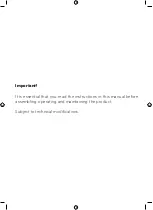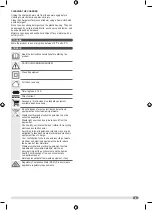
8
Battery pack protection
The battery pack has overload protection that protects it from being
overloaded and helps to ensure long life.
Under extreme stress, the battery electronics turn off the product
automatically. To restart, turn the product off and then on again.
If the product does not start up again, the battery pack may have
discharged completely. Recharge the battery pack.
Transporting lithium batteries
Lithium-ion batteries are subject to the Dangerous Goods
Legislation requirements.
Transportation of those batteries has to be done in accordance with
local, national, and international provisions and regulations.
• Batteries can be transported by road without further requirement.
• Commercial transport of lithium-ion batteries by third parties is
subject to Dangerous Goods regulations. Transport preparation
and transport are exclusively to be carried out by appropriately
trained persons and the process has to be accompanied by
corresponding experts.
When transporting batteries:
• Ensure that the battery contact terminals are protected and
insulated to prevent short circuit.
• Ensure that the battery pack is secured against movement within
the packaging.
• Do not transport batteries that are cracked or leaking.
• Check with the forwarding company for further advice.
SPECIFIED CONDITIONS OF USE
The charger is intended only to charge the compatible battery
packs listed in this manual.
The product is only for indoor use, in dry conditions.
The product is not intended to charge any other type of battery or
be used as a power supply. It should never be used in explosive or
flammable environments.
Do not use the product for any other purpose.
WALL MOUNTING
Carefully select a stable wall for mounting the charger. Make sure
that there is no hindrance to mounting work or operation. The
maximum gross weight of the charger is approximately 3.7 kg,
provide sufficient reinforcement for the wall if necessary.
Mount the charger in a horizontal orientation only. Install two
screws on the wall to mount the charger. Otherwise, the charger
may fall and cause serious injury.
Check the tightness of the screws on a regular basis. Make sure
that the head of the screws fit properly in the wall mounting holes
to hold the charger firmly in place. Otherwise, the charger may fall
because of loose screws.
LED INDICATORS
Continuous orange Battery is being evaluated.
/ Battery is waiting to be
charged.
Flashing orange
Battery is too hot or cold.
Charging will begin when
battery reaches correct
charging temperature.
Flashing green
Battery is being charged.
Continuous green
Charging is complete.
Continuous red
Battery or charger is
defective.
OPERATION
CHARGING THE BATTERY PACK
• Battery packs are shipped in a low charge condition. Therefore,
you should charge them before first use. If the charger does not
charge the battery pack under normal circumstances, bring both
the battery pack and charger to an authorised service centre.
• Make sure that the power supply is normal household voltage,
220–240V, 50Hz, AC only.
• Make sure that the battery pack latch clicks into place and that
the battery pack is secured in the charger before charging.
NOTE
: When two battery packs are connected to the charger,
they are charged at the same time. The charging current is equally
distributed to the charging ports.
NOTE
: When the battery becomes fully charged, the green LED
remains on. It is normal for the battery pack to become slightly
warm to touch while charging.
• Do not place the charger and battery pack in an area of extreme
heat or cold. They work best at normal room temperature.
NOTE
: When charging, the charger and battery pack should be
placed in a location where the temperature is more than 5°C but
less than 40°C.
CHARGING A COOL BATTERY PACK
1. Insert the battery pack into the charging port. Make sure that the
battery pack latch clicks into place.
2. Connect the product to a power supply.
3. Disconnect the product from the power supply when the battery
pack becomes fully charged.
4. Press the battery pack latches to unlock the battery pack from
the product.
5. Remove the battery pack from the product.
CHARGING A HOT BATTERY PACK
When using a tool continuously, the cells in the battery pack
become hot. A hot battery pack should be allowed to cool down for
approximately 30 minutes before recharging.
MAINTENANCE
When not using or when cleaning the product, disconnect it from
the power supply and remove the battery pack.
Avoid using solvents when cleaning plastic parts. Most plastics
are susceptible to various types of commercial solvents. Use clean
cloth or soft brush to remove dirt and dust.
Do not, at any time, let brake fluids, gasoline, petroleum-based
products, and penetrating oils come in contact with plastic parts.
These products contain chemicals that can damage, weaken, or
destroy plastic.
Hazardous voltages are present within the product; do not
disassemble.
If the supply cord is damaged, it must be replaced by a special cord
or assembly available from the manufacturer or its service agent.
Use only AEG accessories and spare parts. Should components
that have not been described need to be replaced, contact one
of our AEG service agents (see our list of guarantee/service
addresses).
If needed, an exploded view of the tool can be ordered. Please
state the Article No. as well as the machine type printed on the
label and order the drawing at your local service agents or directly
at:
Techtronic Industries Australia Pty Ltd
PO Box 1065
Mount Waverley VIC 3149
Tel. no. 1300 234 797
Australia
Techtronic Industries N.Z. Limited
PO Box 12-806
Penrose AUCKLAND 1642
Tel. no. 0800 234 797(0800 AEGPWR)
New Zealand
Summary of Contents for A18DPC
Page 1: ...A18DPC Original instructions ...
Page 3: ...3 p 4 p 5 p 6 LED indicator Keyhole hanger Battery port ...
Page 4: ...4 3 4 2 5 1 ...
Page 5: ...5 100 50ºC 0ºC ...
Page 6: ...6 102 mm 1 2 ...
Page 10: ......
Page 11: ......






























